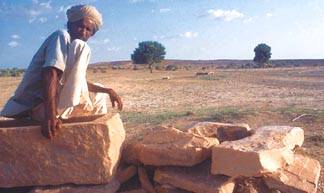| Pokran zero. We stand at a national security
milestone. Here lies the holiest shrine of Indian technological (mis)ability. Here, High
Science priests A P J Abdul Kalam and R Chidambaram recently did puja to nuclear
competence. But we are least interested in either the shrine or this kind of competence.
We are looking for Magga Ram Suthar, who makes beris or kuis. Who with
hammer and ancient acumen makes water available, and so tackles a matter of greater
security and importance.
Magga Ram is making a cot in Village Pithla in Jaisalmer, the famed district in the
heart of the Indian Thar desert. We go with him to the fields of Padam Singh, where some
15 years ago he had made four beris --narrow wells 15 feet deep but only three to
four feet wide. Extraordinary structures. Just how does he make them.
Magga Ram’s 67-year-old eyes turn to the horizon. A man from a nearby village
appears from behind a dune with a camel in tow, easy to spot in the sparse greenery. The
man is lame, the camel one-eyed. The sand is glowing bright in the desiccating heat,
challenging his resilience. In the peak of summer, it will be around a scorching 50°C.
The only shade is that of the odd khejari tree. But there is hope ahead. There is
Magga Ram’s beri.
After reaching the beri, the man lowers a soft bag cut out of the tube of a
truck’s tyre. He draws the sweet, nectarly water, as rare to the Thar as it is to the
taps of Delhi these days. However, when there was not enough water, the villagers did not
agitate against the government, as it happens in Delhi. They sought Magga Ram. Still
earlier, they sought his ancestors.
Magga Ram comes from Pithla’s only suthar family. Suthars are
carpenters, situated way down the caste ladder. But there is no lack of respect for Magga
Ram. He knows how to catch the meagre rainfall that nature assigns to the area during the
monsoon (annual average rainfall is around 160 millimetre).
In Pithla, groundwater can be struck only at a depth of 300-350 feet. Then too it is
mostly saline. Although nature is parsimonious in giving rainwater, there are other gifts.
In many areas, a rocky belt of gypsum runs under the surface. Although its depth varies,
it is generally wide. This is the key to Magga Ram’s art.
The belt can be identified by the moisture retention in the soil. It keeps rainwater
from percolating into the salty groundwater, while the sand covers it from the dehydrating
sunlight. Villages took root only in areas with such belts. This is why the Thar is the
most densely populated desert in the world, both with humans and cattle. But such a gift
cannot be used without a detailed understanding of the region. Magga Ram recalls learning
his art at the knees of his father Uma Ram and his uncle Kala Ram.
After the gypsum belt, known as bittoo, had been marked out by experienced eyes,
digging would start under the supervision of engineers such as Magga Ram. The pit was only
so wide as to permit the artisan to stand. A difficult, dangerous proposition by all
means.
Beris were only dug in the winters to avoid the summer heat. After reaching bittoo,
which in the case of Padam Singh’s fields was 15-feet-deep, the beri was limed
with stones. Magga Ram, an excellent sculptor with his works decorating many a house in
the village, gave the required shape to the stones.
An interesting feature is the shape of beris in areas where bittoo runs
shallow. Magga Ram makes a vase in the air with a measured movement of his slender hands
to explain that the mouth is very narrow to prevent losses due to evaporation. It gets
wider as you go down, giving greater surface area for water to seep in. All the details
were worked out. No paperwork. No project proposals.
Will this art live after Magga Ram? He made his last beri 15 years ago. There is
no demand for new beris. Since 1991 a government tube-well struck sweet water some
seven km away. It reaches water to Pithla through a pipeline. But even today, when the it
fails, villagers walk up to Magga Ram’s beris. There is always water. |






